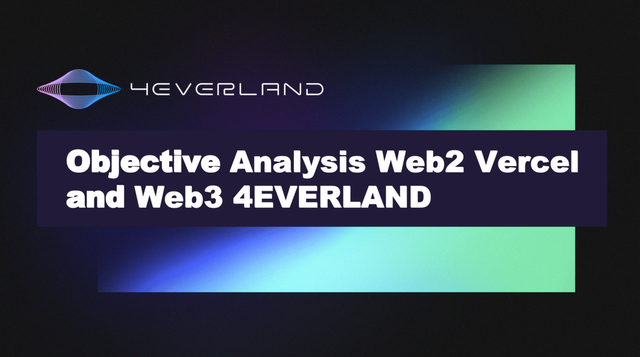
There are centralized and decentralized platforms for application development, with the former taking precedence most of the time. With the launch of the 4EVERLAND platform, developers can now leverage it to build decentralized apps.
Understanding how these Platforms Work
Vercel and 4EVERLAND strive to offer the same service in different ways. Both are application development platforms, with Vercel based on a centralized structure and 4EVERLAND on a decentralized infrastructure.
To that end, they both present a contrast between Web2 and Web3 perspectives on application development.
How Vercel Works
Vercel is a frontend app development and acceleration platform that allows developers to build, test, deploy, and scale their apps.
Vercel makes it easier to manage everything about your app from one interface, from localhost support to supporting several data sources.
We do not forget that the platform promotes collaborative work via the seamless integration with Bitbucket, GitHub, and GitLab.
How 4EVERLAND Works
On the other hand, 4EVERLAND is a decentralized app development platform, ideal for developers looking to build, scale, and distribute apps optimized for the third-generation web.
4EVERLAND also offers global network acceleration and deployment of these Web3 apps via the globally distributed gateway nodes.
Making a “smooth leap” from Web2 to Web3 app development is now easier thanks to the accelerative tendencies of 4EVERLAND. The platform doubles as a blockchain technology-powered cloud computation platform for web-centric apps.
Choosing between Vercel and 4EVERLAND
Choosing any of these app development platforms is beyond convenience. You want to pick the one that aligns with future trends and delivers maximum value.
Here are some of the key differences between the Vercel and 4EVERLAND app development platforms:
Distribution Processes
Vercel promises to facilitate a "dynamic scaling solution," allowing developers to distribute millions of pages “without breaking a sweat.”
On the other hand, 4EVERLAND promises more than that and shows that it is committed to making it work.
Here, app developers use over 200 globally distributed gateway nodes provided by 4EVERLAND. These nodes are the singular pathway to spreading and gaining more comprehensive Web3 access to the distribution channels for the apps.
Pre-Built Solutions
Templates are readily available for developers using either 4EVERLAND or Vercel. For the latter, templates range from client-side React apps, Next.js apps, e-commerce apps, statically generated blogs, and Software-as-a-Service (SaaS) applications.
On the other hand, 4EVERLAND wants the users to thrive on creativity, allowing users and developers to develop creative app ideas. Through the 4EVERLAND DWeb Hosting service, users can deploy applications to Web3 platforms.
We are not leaving out that templates and pre-built solutions are readily available. You can pick any of the custom solutions from the Cli local templates and GitHub interface, make a few changes, and deploy.
Integration Capabilities
Got a choice of framework to work with? Bring them and get access to many integration interfaces on 4EVERLAND and Vercel.
For Vercel, the developers use the Vercel Edge interface to deploy these frameworks with zero configurations. The interface also helps automate the distribution of these frameworks.
One other outstanding integration capability of Vercel’s platform is its request isolation and the use of the Edge Network to run logic and route traffic to be closer to the end users. It also offers most of the tools you need: serverless and edge functions, API hosting, and static assets. All you have to do is sit down and code before deploying.
4EVERLAND offers something better. Here, app developers can freely leverage the Web3 cloud computing platform, which combines all the tools they need—ccomputing, storage, and networking capabilities.
By offering a combination of general-purpose computing solutions, DWeb hosting, data services, a decentralized gateway, and IPFS storage, 4EVERLAND makes the Web2 to Web3 transition easier.
Data Storage
Vercel says it has attained “10 PB" of data served in over 90 cities with 99.99% uptime. However, the platform appears to be doing more “data fetching"—i.e., connecting the apps to different data sources, APIs, and headless CMS.
On the other hand, 4EVERLAND makes data storage and distribution worth it, from the IPFS support to the general-purpose computing layers based on the multiple chain integrations.
Everland’s InterPlanetary File System (IPFS) is a dedicated peer-to-peer (P2P) network and protocol built to enable data storage and distribution. Anything from websites to files, videos, and images is stored in this robust decentralized file system for onward distribution to all the participating nodes.
In addition to the compatibility with open protocols, 4EVERLAND also uses the Swarm technology to form a “colony” of network nodes that use participating nodes to achieve consistent data storage.
4EVERLAND vs Vercel: Which is Better for App Development?
The two platforms provide much-needed tools for app development, but picking one over the other is a matter of convenience and future outlook. As the world transitions to Web3, it is worthwhile to migrate app development to a platform that supports that—4EVERLAND.
In terms of affordability, you want to consider data storage and infrastructure. Vercel offers a free plan for app deployment from both personal GitHub integrations and the CLI. It also provides automatic HTTPS and SSL protocols and built-in CI and CD. However, the paid plan starts at $20 (per user) for a small team with up to 1 terabyte (TB) of bandwidth.
4EVERLAND’s offer is affordable, with a free plan of 250-minute monthly build time, 100GB per month of bandwidth, and 5GB of IPFS storage. When upgrading to a paid plan, it costs only $2 for each additional 100 minutes of build time, $8.5 for an additional 100G of bandwidth, and $0.31 per additional 100MB of Arweave storage.
About 4EVERLAND
4EVERLAND is a Web 3.0 cloud computing platform that integrates storage, computing, and network core capabilities. It aims to help the user to make a smooth leap from Web 2.0 to Web 3.0 and become the infrastructure for millions of Web 3.0 developers and applications.
Join 4EVERLAND community:
Website | Twitter | Telegram | Discord | Reddit | Medium| Email